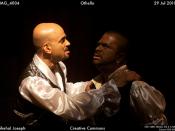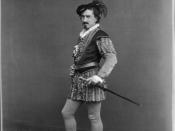Elizabethan and Jacobean dramatists used his theatrical convention to evoke the inwardness of their characters, a soliloquy provides the audience with accurate access to the character's innermost thoughts and we learn more about a character than could ever be gathered from the action of the play alone. In 'Othello', both the hero and the villain speak in soliloquy. Iago, the villain, speaks his soliloquies first (Othello's occur towards the end of the play), drawing the audience in as he outlines his intentions and ideas. The soliloquies give us access to the feelings and motivations of both hero and villain, which heightens the intensity of the drama. They are also a source of a great deal of dramatic irony which increases the dramatic tension for the audience. In 'Othello', the use of soliloquies is crucial as the play is based on deceit and they allow us to know the motive of characters, especially Iago, and we see the characters in their true light as they use language and images which are typical of them.
Iago illustrates the issue of deception through his soliloquies; they are useful as they show Iago's true feelings. Iago's character is presented to us through his soliloquies, illustrating motives which he uses to justify his actions, making the soliloquies instruments to show the audience what makes Iago tick. Language is the source of Iago's power and his soliloquies reinforce this. Iago's soliloquy in Act1 Sc.3 is where he starts to formulate his plan to get back at Othello. When he is alone, he reveals his true motives. First he mocks Roderigo - "Thus do I ever make my fool my purse:" making the audience aware of the fact that he is only using Roderigo. He is toying with Roderigo for...
![From the Library of Congress: TITLE: Thos. W. Keene. Othello CALL NUMBER: POS - TH - 1884 .O7, no. 1 (C size) [P&P] REPRODUCTION NUMBER: LC-USZC6-58 (color film copy transparency) RIGHTS INFORMATION: No known restrictions on publication. MEDIUM: 1 print (](https://s.writework.com/uploads/9/94760/library-congress-title-thos-w-keene-othello-call-number-pos-thumb.jpg)

